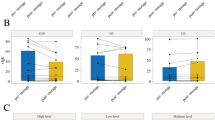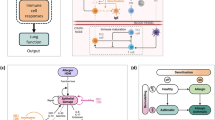Abstract
It is unknown why allergic symptoms do not develop in all sensitized children. We analyzed prospectively the postnatal secretory IgA (SIgA) development and whether high SIgA levels would protect sensitized infants from developing allergic symptoms. Salivary total IgA and SIgA levels were determined by ELISA, and allergy development was investigated at 3, 6, and 12 mo and at 2 and 5 y in two birth cohorts in Estonia (n = 110) and Sweden (n = 91), two geographically adjacent countries with different living conditions and allergy incidence. Total and SIgA levels increased with age, reaching adult levels at the age of 5. Virtually, all salivary IgA in Estonian children was in the secretory form, while a major part of IgA in Swedish saliva lacked the secretory component up to 2 y of age. In Sweden, high levels of salivary IgA without secretory component correlated inversely with house dust endotoxin levels. High SIgA levels were associated with less development of allergic symptoms in sensitized Swedish children. In conclusion, postnatal maturation of the salivary SIgA system proceeds markedly slower in Swedish than Estonian children, possibly as a consequence of low microbial pressure. SIgA may limit allergy-mediated tissue damage at mucosal surfaces in sensitized individuals.
Similar content being viewed by others
Log in or create a free account to read this content
Gain free access to this article, as well as selected content from this journal and more on nature.com
or
Abbreviations
- EU:
-
endotoxin units
- LPS:
-
lipopolysaccharide
- pIgR:
-
polymeric immunoglobulin receptor
- SC:
-
secretory component
- SIgA:
-
secretory IgA
- SPT:
-
skin prick test
References
Cerutti A, Chen K, Chorny A 2011 Immunoglobulin responses at the mucosal interfaces. Annu Rev Immunol 29: 273–293
Cripps AW, Gleeson M, Clancy RL 1991 Ontogeny of the mucosal immune response in children. Adv Exp Med Biol 310: 87–92
Hattevig G, Kjellman B, Björkstén B 1993 Appearance of IgE antibodies to ingested and inhaled allergens during the first 12 years of life in atopic and non-atopic children. Pediatr Allergy Immunol 4: 182–186
Böttcher MF, Häggström P, Björkstén B, Jenmalm MC 2002 Total and allergen-specific immunoglobulin A levels in saliva in relation to the development of allergy in infants up to 2 years of age. Clin Exp Allergy 32: 1293–1298
Kukkonen K, Kuitunen M, Haahtela T, Korpela R, Poussa T, Savilahti E 2010 High intestinal IgA associates with reduced risk of IgE-associated allergic diseases. Pediatr Allergy Immunol 21: 67–73
Devenny A, Wassall H, Ninan T, Omran M, Daud Khan S, Russell G 2004 Respiratory symptoms and atopy in children in Aberdeen: questionnaire studies of a defined school population repeated over 35 years. BMJ 329: 489–490
Bråbäck L, Breborowicz A, Julge K, Knutsson A, Riikjärv MA, Vasar M, Björkstén B 1995 Risk factors for respiratory symptoms and atopic sensitisation in the Baltic area. Arch Dis Child 72: 487–493
von Mutius E, Martinez FD, Fritzsch C, Nicolai T, Roell G, Thieman HH 1994 Prevalence of asthma and atopy in two areas of West and East Germany. Am J Respir Crit Care Med 149: 358–364
Okada H, Kuhn C, Feillet H, Bach JF 2010 The ‘hygiene hypothesis' for autoimmune and allergic diseases: an update. Clin Exp Immunol 160: 1–9
Björkstén B, Sepp E, Julge K, Voor T, Mikelsaar M 2001 Allergy development and the intestinal microflora during the first year of life. J Allergy Clin Immunol 108: 516–520
Penders J, Thijs C, van den Brandt PA, Kummeling I, Snijders B, Stelma F, Adams H, van Ree R, Stobberingh EE 2007 Gut microbiota composition and development of atopic manifestations in infancy: the KOALA Birth Cohort Study. Gut 56: 661–667
Wang M, Karlsson C, Olsson C, Adlerberth I, Wold AE, Strachan DP, Martricardi PM, Aberg N, Perkin MR, Tripodi S, Coates AR, Hesselmar B, Saalman R, Molin G, Ahrné S 2008 Reduced diversity in the early fecal microbiota of infants with atopic eczema. J Allergy Clin Immunol 121: 129–134
Sjögren YM, Jenmalm MC, Böttcher MF, Björkstén B, Sverremark-Ekström E 2009 Altered early infant gut microbiota in children developing allergy up to 5 years of age. Clin Exp Allergy 39: 518–526
Sepp E, Julge K, Vasar M, Naaber P, Björkstén B, Mikelsaar M 1997 Intestinal microflora of Estonian and Swedish infants. Acta Paediatr 86: 956–961
von Mutius E, Vercelli D 2010 Farm living: effects on childhood asthma and allergy. Nat Rev Immunol 10: 861–868
von Mutius E, Braun-Fahrländer C, Schierl R, Riedler J, Ehlermann S, Maisch S, Waser M, Nowak D 2000 Exposure to endotoxin or other bacterial components might protect against the development of atopy. Clin Exp Allergy 30: 1230–1234
Böttcher MF, Björkstén B, Gustafson S, Voor T, Jenmalm MC 2003 Endotoxin levels in Estonian and Swedish house dust and atopy in infancy. Clin Exp Allergy 33: 295–300
Voor T, Julge K, Böttcher MF, Jenmalm MC, Duchén K, Björkstén B 2005 Atopic sensitization and atopic dermatitis in Estonian and Swedish infants. Clin Exp Allergy 35: 153–159
Turner JR 2009 Intestinal mucosal barrier function in health and disease. Nat Rev Immunol 9: 799–809
Rakoff-Nahoum S, Paglino J, Eslami-Varzaneh F, Edberg S, Medzhitov R 2004 Recognition of commensal microflora by toll-like receptors is required for intestinal homeostasis. Cell 118: 229–241
Cripps AW, Gleeson M, Clancy RL 1989 Molecular characteristics of IgA in infant saliva. Scand J Immunol 29: 317–324
Kaetzel CS 2005 The polymeric immunoglobulin receptor: bridging innate and adaptive immune responses at mucosal surfaces. Immunol Rev 206: 83–99
Schneeman TA, Bruno ME, Schjerven H, Johansen FE, Chady L, Kaetzel CS 2005 Regulation of the polymeric Ig receptor by signaling through TLRs 3 and 4: linking innate and adaptive immune responses. J Immunol 175: 376–384
Hooper LV, Wong MH, Thelin A, Hansson L, Falk PG, Gordon JI 2001 Molecular analysis of commensal host-microbial relationships in the intestine. Science 291: 881–884
Sjögren YM, Tomicic S, Lundberg A, Böttcher MF, Björkstén B, Sverremark-Ekström E, Jenmalm MC 2009 Influence of early gut microbiota on the maturation of childhood mucosal and systemic immune responses. Clin Exp Allergy 39: 1842–1851
Sandin A, Björkstén B, Böttcher MF, Englund E, Jenmalm MC, Bråbäck L 2011 High salivary secretory IgA antibody levels are associated with less late-onset wheezing in IgE-sensitized infants. Pediatr Allergy Immunol 2: 477–481
Schwarze J, Cieslewicz G, Joetham A, Sun LK, Sun WN, Chang TW, Hamelmann E, Gelfand EW 1998 Antigen-specific immunoglobulin-A prevents increased airway responsiveness and lung eosinophilia after airway challenge in sensitized mice. Am J Respir Crit Care Med 158: 519–525
Hajek AR, Lindley AR, Favoreto S Jr, Carter R, Schleimer RP, Kuperman DA 2008 12/15-Lipoxygenase deficiency protects mice from allergic airways inflammation and increases secretory IgA levels. J Allergy Clin Immunol 122: 633–639.e3
Smits HH, Gloudemans AK, van Nimwegen M, Willart MA, Soullie T, Muskens F, de Jong EC, Boon L, Pilette C, Johansen FE, Hoogsteden HC, Hammad H, Lambrecht BN 2009 Cholera toxin B suppresses allergic inflammation through induction of secretory IgA. Mucosal Immunol 2: 331–339
Pilette C, Nouri-Aria KT, Jacobson MR, Wilcock LK, Detry B, Walker SM, Francis JN, Durham SR 2007 Grass pollen immunotherapy induces an allergen-specific IgA2 antibody response associated with mucosal TGF-beta expression. J Immunol 178: 4658–4666
Ewing P, Otczyk DC, Occhipinti S, Kyd JM, Gleeson M, Cripps AW 2010 Developmental profiles of mucosal immunity in pre-school children. Clin Dev Immunol 2010: 196785
Acknowledgements
We thank the research nurse Lena Lindell for her enthusiastic work guiding the families through the study and all sampling procedures; Ulrika Bengtsson, Anne-Marie Fornander, and Tiina Rebane for excellent technical assistance; and Dr. Karel Duchén for clinical evaluation. We also thank Professor Patrick Holt and Professor Per Brandtzaeg for critical reading and their valuable suggestions for improving the manuscript.
Author information
Authors and Affiliations
Corresponding author
Additional information
Supported by grants from the Swedish Research Council, the National Heart and Lung Association, The Vårdal Foundation for Health Care Sciences and Allergy Research, the National Swedish Association against Allergic Diseases, and the County Council of Östergötland.
The authors report no conflicts of interest.
Rights and permissions
About this article
Cite this article
Fagerås, M., Tomičić, S., Voor, T. et al. Slow Salivary Secretory IgA Maturation May Relate to Low Microbial Pressure and Allergic Symptoms in Sensitized Children. Pediatr Res 70, 572–577 (2011). https://doi.org/10.1203/PDR.0b013e318232169e
Received:
Accepted:
Issue date:
DOI: https://doi.org/10.1203/PDR.0b013e318232169e
This article is cited by
-
Peach extract induces systemic and local immune responses in an experimental food allergy model
Scientific Reports (2023)
-
Allergic rhinitis, allergic contact dermatitis and disease comorbidity belong to separate entities with distinct composition of T-cell subsets, cytokines, immunoglobulins and autoantibodies
Allergy, Asthma & Clinical Immunology (2022)
-
Effect of nasal antihistamine on secretory IgA in nasal lavage of rats
European Archives of Oto-Rhino-Laryngology (2018)
-
Lactation and Intestinal Microbiota: How Early Diet Shapes the Infant Gut
Journal of Mammary Gland Biology and Neoplasia (2015)



